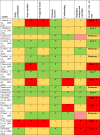Prognostic Factors and Models for Predicting Work Absence in Adults with Musculoskeletal Conditions Consulting a Healthcare Practitioner: A Systematic Review
- PMID: 38753046
- PMCID: PMC12089206
- DOI: 10.1007/s10926-024-10205-y
Prognostic Factors and Models for Predicting Work Absence in Adults with Musculoskeletal Conditions Consulting a Healthcare Practitioner: A Systematic Review
Abstract
Purpose: It is difficult to predict which employees, in particular those with musculoskeletal pain, will return to work quickly without additional vocational advice and support, which employees will require this support and what levels of support are most appropriate. Consequently, there is no way of ensuring the right individuals are directed towards the right services to support their occupational health needs. The aim of this review will be to identify prognostic factors for duration of work absence in those already absent and examine the utility of prognostic models for work absence.
Methods: Eight databases were search using a combination of subject headings and key words focusing on work absence, musculoskeletal pain and prognosis. Two authors independently assessed the eligibility of studies, extracted data from all eligible studies and assessed risk of bias using the QUIPS or PROBAST tools, an adapted GRADE was used to assess the strength of the evidence. To make sense of the data prognostic variables were grouped according to categories from the Disability Prevention Framework and the SWiM framework was utilised to synthesise findings.
Results: A total of 23 studies were included in the review, including 13 prognostic models and a total of 110 individual prognostic factors. Overall, the evidence for all prognostic factors was weak, although there was some evidence that older age and better recovery expectations were protective of future absence and that previous absence was likely to predict future absences. There was weak evidence for any of the prognostic models in determining future sickness absence.
Conclusion: Analysis was difficult due to the wide range of measures of both prognostic factors and outcome and the differing timescales for follow-up. Future research should ensure that consistent measures are employed and where possible these should be in-line with those suggested by Ravinskaya et al. (2023).
Keywords: Absence; Musculoskeletal pain; Prognosis; Systematic review; Work absence.
© 2024. The Author(s).
Conflict of interest statement
Declarations. Competing interests: The authors declare no competing interests.
Figures
Similar articles
-
Risk assessment for prolonged sickness absence due to musculoskeletal disorders: protocol for a prospective cohort study.BMC Musculoskelet Disord. 2020 May 25;21(1):326. doi: 10.1186/s12891-020-03354-7. BMC Musculoskelet Disord. 2020. PMID: 32450820 Free PMC article.
-
Managing sickness absence of patients with musculoskeletal pain - a cross-sectional survey of Scandinavian chiropractors.Chiropr Man Therap. 2019 Jan 11;27:1. doi: 10.1186/s12998-018-0230-y. eCollection 2019. Chiropr Man Therap. 2019. PMID: 30651973 Free PMC article.
-
Approaches for predicting long-term sickness absence. Re: Schouten et al. "Screening manual and office workers for risk of long-term sickness absence: cut-off points for the Work Ability Index".Scand J Work Environ Health. 2015 May 1;41(3):322-323. doi: 10.5271/sjweh.3483. Epub 2015 Feb 2. Scand J Work Environ Health. 2015. PMID: 25639964
-
Interventions to improve return to work in depressed people.Cochrane Database Syst Rev. 2020 Oct 13;10(10):CD006237. doi: 10.1002/14651858.CD006237.pub4. Cochrane Database Syst Rev. 2020. PMID: 33052607 Free PMC article.
-
Systematic review and tools appraisal of prognostic factors of return to work in workers on sick leave due to musculoskeletal and common mental disorders.PLoS One. 2024 Jul 17;19(7):e0307284. doi: 10.1371/journal.pone.0307284. eCollection 2024. PLoS One. 2024. PMID: 39018306 Free PMC article.
Cited by
-
Predicting prolonged work absence due to musculoskeletal disorders: development, validation, and clinical usefulness of prognostic prediction models.Int Arch Occup Environ Health. 2025 Jul;98(4-5):385-397. doi: 10.1007/s00420-025-02129-8. Epub 2025 Apr 8. Int Arch Occup Environ Health. 2025. PMID: 40198330 Free PMC article.
References
-
- Zheltoukhova K. Musculoskeletal disorders and work: results of a survey of individuals living with musculoskeletal disorders in six European countries. Great Britain: The Work Foundation (Lancaster University); 2013.
-
- Krause N, Dasinger LK, Deegan LJ, Rudolph L, Brand RJ. Psychosocial job factors and return-to-work after compensated low back injury: a disability phase-specific analysis. Am J Ind Med. 2001;40(4):374–92. 10.1002/ajim.1112. - PubMed
-
- Dekkers-Sánchez PM, Haije W, Sluiter JK, Frings-Dresen MHW. A qualitative study of perpetuating factors for longterm sick leave and promoting factors for return to work: chronic work disabled patients in their own words. J Rehabil Med. 2010;42(6):544–52. 10.2340/16501977-0544. - PubMed
-
- “Overview | Workplace health: long-term sickness absence and capability to work | Guidance | NICE.” Accessed: Nov. 24, 2023. [Online]. Available: https://www.nice.org.uk/guidance/ng146
Publication types
MeSH terms
Grants and funding
LinkOut - more resources
Full Text Sources





